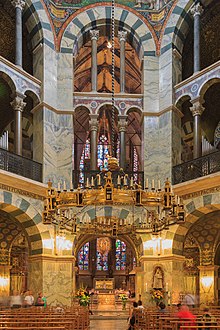User:CharlieJPerriss/sandbox
Palaces
[edit]
No permanent capital city existed in the empire, the itinerant court being a typical characteristic of all Western European kingdoms at this time. Some "main residences" can, however, be distinguished. In the first year of his reign, Charlemagne went to Aachen (French: Aix-la-Chapelle; Italian: Aquisgrana). He began to build a palace there in the 780s[1] with planning beginning perhaps as soon as 768.[1] The palace chapel, constructed in 796, later became Aachen Cathedral. During the 790s when construction picked up at Aachen, Charlemagne's court became more static compared with the 770s. Though Aachen was certainly not intended to be a sedentary capital it was built in the political heartland of Charlemagne's realm to act as a meeting place for aristocrats and churchmen so that patronage might be distributed, assemblies held, and laws written.[2] Aachen was also a centre for information and gossip being pulled in from across the Empire by courtiers and churchmen alike.[3] Of course, despite being the centre of Charlemagne's government, until his later years, his court moved often and made use of other palaces at Frankfurt, Ingelheim and Nijmegen and the use of such magnificent and permanent structures would be the beginnings of the palace system of government used by the Carolingian court throughout the Empire's existence.[4] Stuart Airlie has suggested that there were over 150 palaces throughout the Carolingian World which would provide the setting for court activity.[3]
Palaces were not merely locations of administrative government but also stood as important symbols. Under Charlemagne their excellence was a translation of the treasure built up from conquest into a symbolic permanence as well as exclaiming royal authority.[4][3] Einhard suggested the construction of so-called 'public buildings' was a testament to Charlemagne's greatness and likeness to the emperors of antiquity and this connection were certainly capitalised on by the imagery of palace decorations. Ingelheim is a particular example of such symbolism and thus the importance of the palace system in more than mere governance. The palace chapel is written to have been 'lined with images from the Bible' and the hall of the palace 'decorated with a picture cycle celebrating the deeds of great kings' including rulers of antiquity as well as Carolingian rulers such as Charles Martel and Pippin III.[4][3]
Louis the Pious used the palace system much to the same effect as Charlemagne during his reign as king of Aquitaine, rotating his court between four winter palaces throughout the region.[4] During his reign as Emperor he used Aachen, Ingelheim, Frankfurt, and Mainz which were almost always the locations for general assemblies held 'two or three [times] a year in the period 896-28...' and while he was not an immobile ruler, his reign has certainly been described as more static.[4] In this way the palace system can also been seen as a tool of continuity in governance. After the splintering of the Empire the palace system continued to be used by succeeding Carolingian rulers with Charles the Bald centring his power at Compiègne[5] where the palace chapel was dedicated to the Virgin Mary in 877, something remarked on as a sign of continuity with Aachen's Mother of God chapel.[6] For Louis the German, Frankfurt has been deemed his own 'neo-Aachen' and Charles the Fat's palace at Sélestat in Alsace was designed specifically to imitate Aachen.[6]
Palace System in Historiography
[edit]The palace system as an idea for Carolingian central administration and governance has been challenged by historian F. L. Ganshof who argued that the palaces of the Carolingians 'contained nothing resembling the specialised services and departments available at the same period to the Byzantine emperor or the caliph of Baghdad.'[7] However, further reading in the works of Carolingian historians such as Matthew Innes, Rosamond McKitterick, and Stuart Airlie suggest that the use of palaces were important in the evolution of Carolingian governance and Janet Nelson has argued that 'palaces are places from which power emanates and is exercised...' and the importance of palaces to Carolingian administration, learning, and legitimacy has been widely argued.
- ^ a b Nelson, Janet (2019). King and Emperor: A New Life of Charlemagne. London: Allen Lane. pp. 232, 356.
- ^ Innes, Matthew (2005). "Charlemagne's Government". In Story, Joanna (ed.). Charlemagne: Empire and Society. Manchester University Press. p. 2.
{{cite book}}: no-break space character in|title=at position 13 (help) - ^ a b c d Airlie, Stuart (2012). Power and Its Problems in Carolingian Europe. Ashgate. pp. 4–11.
- ^ a b c d e Costambeys, Mario (2011). The Carolingian World. Cambridge University Press. pp. 173–177.
- ^ McKitterick, Rosamond (1983). The Frankish Kingdoms Under The Carolingians 751-987. Longman. p. 22.
- ^ a b Costambeys, Mario (2011). The Carolingian World. Cambridge University Press. pp. 410–411.
- ^ Ganshof, F. L. (1971). The Carolingians and the Frankish Monarchy. Translated by Sondheimer, Janet. Longman. p. 257.
